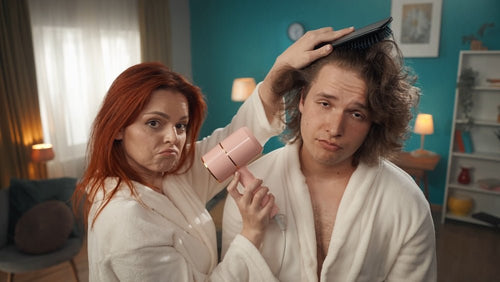Outline
Introduction
Waking up to dry, tangled, or frizzy strands even after moisturizing the night before? You might be dealing with high porosity hair.
While every hair type has its own quirks, high porosity hair brings a specific set of challenges—but with the right knowledge and care, you can transform brittle strands into bouncy, hydrated locks.
What is High Porosity Hair?
Hair porosity refers to how well your hair can absorb and retain moisture. High porosity hair has a raised or damaged cuticle layer, which means moisture can enter easily—but also escapes just as quickly.
This condition may be due to genetics, frequent heat styling, chemical treatments, or even environmental stressors like sun exposure or harsh shampoos.
But aside from causes, some hair types are naturally more prone to high porosity—and understanding that can help you better care for your hair.
Which Hair Types Are More Likely to Be High Porosity?
While high porosity can affect anyone, certain hair types are more commonly affected—either naturally or due to external styling habits.
1. Type 3 Hair and Type 4 Hair (Curly and Coily Hair)
Curly, coily, and kinky hair textures—especially Type 3B to 4C—tend to be more porous by nature. The twists and coils create more cuticle openings, making it harder for natural oils to travel from root to tip. As a result, the hair is often drier and more vulnerable to breakage.
Many people with natural hair also go through chemical or heat-based processes (like straightening, blowouts, or coloring), which further compromise the hair’s cuticle structure and increase porosity.
2. Color-Treated or Bleached Hair
Regardless of curl pattern, bleaching or dyeing your hair increases porosity. Chemical treatments break down the cuticle layer to deposit color, leaving hair strands more open and fragile. Over time, this creates the textbook symptoms of high porosity: dry ends, breakage, and frizz.
3. Fine Hair with Damage
Even fine hair or straight hair (such as Type 1B to 2A) can become highly porous if it’s frequently exposed to heat styling, sun damage, or chemical relaxers. These hair types may not look frizzy in the same way curly hair does, but they can feel brittle, limp, or overly dry.
4. Aging Hair
Hair changes as we age. Hormonal shifts and years of accumulated styling or UV damage can leave the hair more porous—even for people who didn’t have porosity issues in their youth.
Signs You Have High Porosity Hair
Not sure if your hair falls into this category? Here are some tell-tale signs of high porosity hair:
- Your hair dries very quickly after washing
- You experience chronic dryness no matter how often you moisturize
- Frizz and tangles are a constant battle
- Products seem to 'disappear' into your hair without much effect
- Color fades fast after dyeing your hair
- You deal with split ends and breakage often
Quick Test: Drop a clean strand of your hair into a glass of water. If it sinks quickly, it’s likely highly porous.

Common Problems with High Porosity Hair
High porosity hair isn't 'bad' hair—it’s just hair that needs a different strategy. However, without the right care, you may face ongoing issues like:
Moisture loss: You can moisturize all you want, but unless you seal that moisture in, it’ll evaporate quickly.
Protein imbalance: The cuticle damage often leads to protein loss, resulting in weak, limp hair.
Frizz and puffiness: The open cuticles allow excess moisture from the air to enter, causing swelling and frizz.
Increased breakage: Without proper protection and hydration, high porosity hair is prone to split ends and breakage.
How to Build a Daily and Nightly Routine
Consistency is everything. With high porosity hair, a tailored routine can help lock in moisture, strengthen strands, and bring out your natural beauty.
Morning Routine:
1. Gentle Cleanser (as needed): Use a sulfate-free shampoo or co-wash to avoid stripping the hair of its natural oils.
2. Leave-in Conditioner: Look for a lightweight, water-based leave-in that hydrates without buildup.
3. Seal with Oil or Butter: After applying your leave-in, use an oil like argan, avocado, or castor oil to trap the moisture in.
4. Protective Styling: Styles like braids, buns, or twists help reduce friction and exposure.
Night Routine:
1. Moisturize Lightly: Use a small amount of hydrating mist or leave-in spray.
2. Seal with a Butter-Based Product: Shea or mango butter can help prevent moisture loss overnight.
3. Protect Your Hair: Sleep with a silk or Bonnet Queen satin bonnet or pillowcase.
Best Products for High Porosity Hair
The key to caring for high porosity hair lies in using the right products that hydrate, strengthen, and seal in moisture.
1. Deep Conditioners with Protein (Hero Product!):
High porosity hair often suffers from protein loss, so a protein-rich deep conditioner is your best friend. Use once a week.
2. Moisturizing Leave-In Conditioners:
Choose creamy leave-ins that contain humectants like glycerin, aloe vera, coconut oil, and panthenol.
3. Sealants:
After applying moisture, lock it in with oils or butters like shea butter, mango butter, or castor oil.
4. Low pH Products:
Products with a slightly acidic pH help close the cuticle layer, reducing frizz and enhancing shine.
FAQs About High Porosity Hair
Q: Can high porosity hair be reversed?
A: While you can’t change your hair’s natural porosity, you can improve its condition by minimizing damage.
Q: Should I avoid protein?
A: No—high porosity hair usually needs protein. Just don’t overdo it.
Q: Is heat styling bad for high porosity hair?
A: Excessive heat can worsen porosity. Use heat protectants and moderate temperatures.
Q: How often should I wash high porosity hair?
A: 1–2 times per week is ideal. Overwashing can strip necessary oils.
Q: Can I color my hair if it’s highly porous?
A: You can, but be cautious. Deep conditioning before and after helps reduce damage.
Final Words
High porosity hair may require a bit more love, but with the right care, it can thrive. Focus on moisture, balance with protein, and protect your strands from external stressors.
Choosing the right high porosity hair products and staying consistent with your routine will not only prevent damage but also bring out the best in your natural texture.
Remember—your hair isn’t 'bad' or 'difficult.' It’s just waiting for the care it deserves.



